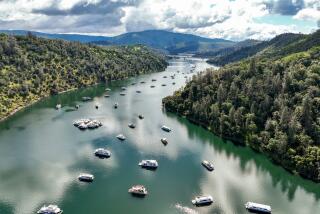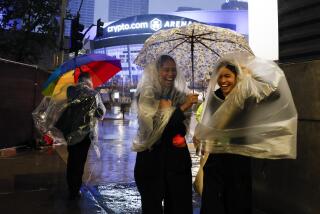State Heads for Rare 3rd Straight Year of Drought
- Share via
OROVILLE, Calif. — A disappointingly dry January is pushing California toward a remarkable third consecutive year of drought, state water managers say as they survey shrunken reservoir levels and vanishing mountain snowpacks.
Scientists believe that the state has not suffered three consecutive drought years in nearly 400 years. They base this belief both on recorded history and data extrapolated from growth rings on ancient trees. Narrow rings, showing little growth in a particular year, indicate drought.
The current gloomy outlook arises because California’s rainy season is more than half over, but its reservoirs are not half full. Despite bountiful snow for skiers, climatic conditions are such that the state is not getting enough runoff where it is needed--in the Northern California hills that feed major reservoirs. Runoff has dipped to 47% of normal this year, officials said.
“It will take a lot of rainfall to bring us up to where we were last year, and last year was the second year of a drought,” said William J. Helms, chief of the state drought center in Sacramento.
While rainfall in Orange County is below normal for the second successive season, water experts played down fears about a local drought.
“Nobody will have to go thirsty this summer,” said Jim Van Haun, spokesman for the Orange County Water District, which supplies water to about 40% of households in the county.
Orange County gets two-thirds of its water supply from the Colorado River and local groundwater basins, all of which are up to their normal levels, Van Haun said.
Only a third of Orange County’s water supply is dependent on the Northern California snowpack and rainfall, Van Haun added. “We’re not as impacted as other parts of the state.”
Art Bruington, a consultant to the Municipal Water District of Orange County, agreed but warned that Southland residents should take steps to save water, if only to emphasize that Southern Californians are conscious of the statewide water situation.
“We’re not in a bad situation yet,” Bruington said. “Rationing is probably not in the cards for Southern California. But politically, we have to be sensitive to shortages that occur in Northern California.”
Bay Area cities last year imposed a mandatory 25% rationing cut on water users, Bruington said.
Orange County users, who were asked to reduce water use voluntarily by 10% last year, cut down by 8%, Bruington said. And local water officials may ask for a second year of voluntary water rationing if more rain and snow do not fall on the Sierra, he noted.
“If the situation does not improve in Northern California, we’ll probably have another voluntary water conservation program again this year,” Bruington said.
Despite a seemingly wet winter season, rainfall in Orange County has been below that of last year.
In Santa Ana, 5.6 inches of rain has fallen since July 1, compared to 7.7 inches for the same period last year. The average rainfall for the season through Jan. 30 is 6.09 inches, according to county Environmental Management Agency records.
Measurements taken at Santiago Peak show 14.57 inches of rainfall for the season to date, slightly ahead of the average of 14.28 inches, but well below last season’s 17.96 inches for the same period. In Costa Mesa, 4.47 inches has fallen so far this season, compared to 5.95 inches last year and the normal average of 5.54 inches.
Official drought watchers have said that the state would require at least 70% of normal capacity in every major reservoir as well as an above-average snowpack before the Department of Water Resources could even consider calling an end to the drought.
Helms said there is only a 50% chance that rainfall in February and March will be sufficient to obviate plans for significant mandatory rationing. Farmers already have been told to expect 40% less irrigation water this year, and urban water agencies are being urged to redouble their conservation efforts.
The Los Angeles Department of Water and Power, which has its own independent sources of water from the eastern Sierra, is in no better shape, spokesman Jim Wickser said. The snowpack on which it depends is only 70% of normal for this time of year and would need to be close to 150% of normal through March to recover.
“I think we’ll be looking for mandatory conservation in the city of Los Angeles if things do not improve,” Wickser said. He added that voluntary conservation programs in use now will not save enough water to make a difference.
Helms said that as bad as the situation is, the state’s water situation is not yet as desperate as it was during the 1976-77 drought. He said this is because several new reservoirs have been added in the last decade and water management and conservation practices have improved.
However, he cautioned that a third year of drought now could again prove a problem. Ironically, Northern California cities would be most dramatically affected because they rely much more on runoff from the Sierra.
With 2 months remaining in the rainy season, Helms and Libby are hopeful that the state can recoup its usual water reserves, but figures show that precipitation through the end of the 7-month rainy season in April would have to be 130% of normal to do so.
Meteorologist Dave Beusterien of WeatherData Inc., which supplies forecasts to The Times, said Monday that changes in the jet stream should bring above-normal precipitation to Central and Northern California in the next 2 weeks, but probably not 130% of normal.
On the land feeding Lake Oroville, the largest State Water Project reservoir, only 13.46 inches of rain, about 24% less than usual, has fallen so far this season. Much of what did fall was soaked up by desiccated mountain soils before reaching the lake.
As a result, the lake, already sapped by 2 years of drought, now holds less than half its capacity and about 69% of its average historical volume for this time of year. Other lakes are faring even worse. Federally managed Lake Shasta, California’s largest reservoir, has only 40% of capacity, while Folsom Lake near Sacramento contains only 30%.
These reservoirs and others in the northern third of California are critical because they represent the bulk of the state’s storage capacity of surface water. Central California has far fewer facilities to help it through the summer and Southern California has fewer still. Both regions rely on northern water sent south through managed rivers and aqueducts.
This year’s lack of runoff is nowhere more evident than at Lake Oroville, where water operations manager Ronald M. Libby can drive his pickup across acres of dry, red clay lake bed to oversee work crews repairing floats and other gear that have been beached by the receding water.
Snow Doesn’t Help
The tree line ringing the reservoir and demarcating the normal high-water mark looms 150 feet above the lake level. Boat ramps barely stretch to the lake surface and several abandoned cars have been exposed on the sloping sides of the reservoir after years of submersion.
Enough snow has blanketed the Sierra Nevada to delight skiers this winter, but the snowpack is proving a disappointment to water officials for a number of reasons. It is so fluffy that it has a below-average water content, and without replenishment it has slowly been shrinking--from 115% of normal at the start of the month to 90% last week.
“Each snowless day it drops another percentage point,” Helms said.
As it melts, however, it does not benefit the reservoirs.
“We have a lot of snow up there, but it has all fallen on a sponge,” Libby said, referring to dry soils. “What little has melted so far has soaked right into the ground.”
Staff writer Lonn Johnston in Orange County contributed to this story.
MEASURING THE DROUGHT
Disappointing precipitation in the first half of California’s rainy season has left water levels so low at drought-starved Lake Oroville, above, that service boats are dwarfed by the exposed, sloping lake bed. Water level is 150 feet below capacity.
Water managers measure the severity of California droughts by the amount of water in remote Northern California reservoirs like Oroville. Rainfall in cities is less important because cities lack storage systems large enough to carry them through dry summers. Storage at 70% of historical average in all reservoirs is needed to avoid shortages. These storage data for selected reservoirs in California are as of Jan. 24; all figures are expressed in acre-feet, a standard water measurement equal to 325,800 gallons.
RESERVOIR MAXIMUM CURRENT YEAR AGO HIST. AVG. NAME CAPACITY STORAGE THIS DATE THIS DATE Oroville 3,538,000 1,692,000 2,613,000 2,450,000 (47.8% of capacity; 69.1% of historical average to date) Shasta 4,552,000 1,844,000 3,308,000 3,232,000 (40.5% of capacity; 57.1% of historical average to date) Folsom 1,010,000 298,000 386,000 588,000 (29.5% of capacity; 50.7% of historical average to date) Claire Engle 2,448,000 1,266,000 1,669,000 1,848,000 (51.7% of capacity; 68.5% of historical average to date)
Source: California Department of Water Resources
More to Read
Sign up for Essential California
The most important California stories and recommendations in your inbox every morning.
You may occasionally receive promotional content from the Los Angeles Times.










